| Listing 1 - 6 of 6 |
Sort by
|
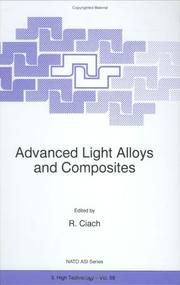
ISBN: 079235222X 9048150876 9401590680 Year: 1998 Volume: 59 Publisher: Dordrecht : Kluwer,
Abstract | Keywords | Export | Availability | Bookmark
 Loading...
Loading...Choose an application
- Reference Manager
- EndNote
- RefWorks (Direct export to RefWorks)
An expert exposition of the structural and mechanical properties of light alloys and composites, bridging the gap between scientists and industrial engineers in its consideration of advanced light materials, their structure, properties, technology and application. Includes basic problems of alloy constitution and phase transformations. The aluminium alloys are the main topic of the book, consideration being given to their properties, casting technology, thermomechanical treatment and structure. Attention is also given to the magnesium alloys, particularly those having rare earth metal constituents. Both commercial titanium alloys and intermetallic compounds are discussed, as are metallic composites. The latest engineering techniques are discussed in both theoretical and practical terms.
Metals. --- Materials science. --- Metallic Materials. --- Characterization and Evaluation of Materials. --- Material science --- Physical sciences --- Metallic elements --- Chemical elements --- Ores --- Metallurgy --- Alloys --- Aluminum compounds --- Metal matrix composites
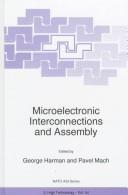
ISBN: 0792351398 9780792351399 9401061599 9401151350 Year: 1998 Volume: 54 Publisher: Dordrecht : Kluwer,
Abstract | Keywords | Export | Availability | Bookmark
 Loading...
Loading...Choose an application
- Reference Manager
- EndNote
- RefWorks (Direct export to RefWorks)
MICROELECTRONIC INTERCONNECTIONS AND MICROASSEMBL Y WORKSHOP 18-21 May 1996, Prague, Czech Republic Conference Organizers: George Harman, NIST (USA) and Pavel Mach (Czech Republic) Summary of the Technical Program Thirty two presentations were given in eight technical sessions at the Workshop. A list of these sessions and their chairpersons is attached below. The Workshop was devoted to the technical aspects of advanced interconnections and microassembly, but also included papers on the education issues required to prepare students to work in these areas. In addition to new technical developments, several papers presented overviews predicting the future directions of these technologies. The basic issue is that electronic systems will continue to be miniaturized and at the same time performance must continue to improve. Various industry roadmaps were discussed as well as new smaller packaging and interconnection concepts. The newest chip packages are often based on the selection of an appropriate interconnection method. An example is the chip-scale package, which has horizontal (x-y) dimensions,;; 20% larger than the actual silicon chip itself. The chip is often flip-chip connected to a micro ball-grid-array, but direct chip attach was described also. Several papers described advances in the manufacture of such packages.
Microelectronic packaging --- Congresses --- Mechanical Engineering --- Engineering & Applied Sciences --- Mechanical Engineering - General --- Electrical & Computer Engineering --- Electrical Engineering --- Manufactures. --- Metals. --- Optical materials. --- Electronic materials. --- Materials science. --- Electrical engineering. --- Manufacturing, Machines, Tools, Processes. --- Metallic Materials. --- Optical and Electronic Materials. --- Characterization and Evaluation of Materials. --- Electrical Engineering. --- Electric engineering --- Engineering --- Material science --- Physical sciences --- Electronic materials --- Optics --- Materials --- Metallic elements --- Chemical elements --- Ores --- Metallurgy --- Manufactured goods --- Manufactured products --- Products --- Products, Manufactured --- Commercial products --- Manufacturing industries --- Microelectronic packaging - Congresses --- Adhesive bonding --- Electronic packages --- Films --- Microelectronics --- Soldering
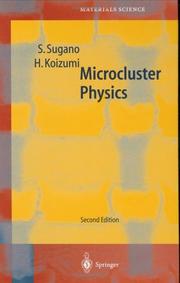
ISBN: 3540639748 3642637930 364258926X Year: 1998 Volume: 20 Publisher: Berlin ; New York : Springer,
Abstract | Keywords | Export | Availability | Bookmark
 Loading...
Loading...Choose an application
- Reference Manager
- EndNote
- RefWorks (Direct export to RefWorks)
Microcluster Physics provides a lucid account of the fundamental physics of all types of microclusters, outlining the dynamics and static properties of this new phase of matter, which is intermediate between a solid and a molecule. Since the original book was published in 1991, the field of microclusters has experienced surprising developments, which are reviewed in this new edition: the determination of atomic structure, spontaneous alloying, the super-shell, fission, fragmentation, evaporation, magnetism, fullerenes, nanotubes, atomic structure of large silicon clusters, superfluidity of He clusters, water clusters in liquid, electron correlation and optimizsation of the geometry, and scattering.
Solid state physics --- Microclusters. --- Metal clusters. --- Fullerenes. --- Microagrégats --- Agrégats métalliques --- Fullerènes --- Microagrégats --- Agrégats métalliques --- Fullerènes --- Atoms. --- Physics. --- Nanotechnology. --- Inorganic chemistry. --- Atomic structure . --- Molecular structure . --- Metals. --- Atomic, Molecular, Optical and Plasma Physics. --- Inorganic Chemistry. --- Atomic/Molecular Structure and Spectra. --- Metallic Materials. --- Metallic elements --- Chemical elements --- Ores --- Metallurgy --- Structure, Molecular --- Chemical structure --- Structural bioinformatics --- Structure, Atomic --- Atomic theory --- Inorganic chemistry --- Chemistry --- Inorganic compounds --- Molecular technology --- Nanoscale technology --- High technology --- Natural philosophy --- Philosophy, Natural --- Physical sciences --- Dynamics --- Chemistry, Physical and theoretical --- Matter --- Stereochemistry --- Constitution --- Carbon --- Colloidal metal particles --- Metal particles, Colloidal --- Microclusters --- Atomic clusters --- Clusters, Atomic --- Clusters, Molecular --- Microcluster physics --- Molecular clusters --- Atoms --- Microphysics
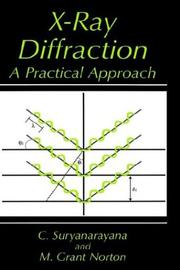
ISBN: 030645744X 1489901507 1489901485 Year: 1998 Publisher: New York (N.Y.) Plenum
Abstract | Keywords | Export | Availability | Bookmark
 Loading...
Loading...Choose an application
- Reference Manager
- EndNote
- RefWorks (Direct export to RefWorks)
In this, the only book available to combine both theoretical and practical aspects of x-ray diffraction, the authors emphasize a "hands on" approach through experiments and examples based on actual laboratory data. Part I presents the basics of x-ray diffraction and explains its use in obtaining structural and chemical information. In Part II, eight experimental modules enable the students to gain an appreciation for what information can be obtained by x-ray diffraction and how to interpret it. Examples from all classes of materials -- metals, ceramics, semiconductors, and polymers -- are included. Diffraction patterns and Bragg angles are provided for students without diffractometers. 192 illustrations.
535.42 --- 548.73 --- Diffraction --- X-ray analysis (Roentgen radiography) of crystals. X-ray investigation of properties. X-ray structure --- X-rays --- Experiments. --- Technique. --- 548.73 X-ray analysis (Roentgen radiography) of crystals. X-ray investigation of properties. X-ray structure --- 535.42 Diffraction --- Rays, Roentgen --- Roentgen rays --- Roentgenograms --- Electromagnetic waves --- Ionizing radiation --- Radiation --- Cathode rays --- Radiography --- Vacuum-tubes --- Diffraction&delete& --- Experiments --- Technique --- Materials science. --- Metals. --- Earth sciences. --- Characterization and Evaluation of Materials. --- Metallic Materials. --- Earth Sciences, general. --- Geosciences --- Environmental sciences --- Physical sciences --- Metallic elements --- Chemical elements --- Ores --- Metallurgy --- Material science
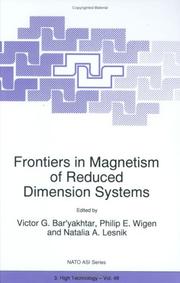
ISBN: 079235026X 9401061017 9401150044 Year: 1998 Volume: 49 Publisher: Dordrecht : Kluwer,
Abstract | Keywords | Export | Availability | Bookmark
 Loading...
Loading...Choose an application
- Reference Manager
- EndNote
- RefWorks (Direct export to RefWorks)
Frontiers in Magnetism of Reduced Dimension Systems presents a definitive statement of our current knowledge and the state of the art in a field that has yet to achieve maturity, even though there are a number of potential applications of thin magnetic films and multilayers, such as magnetic sensors, data storage/retrieval media, actuators, etc. The book is organized into 13 chapters, each including a lecture and contributed papers on a similar subject. Five chapters deal with theoretical descriptions of electron transport phenomena, relaxation processes, nonlinear paramagnetic interactions, phase transitions and macroscopic quantum effects in magnetic films and particles. The description of different characterization techniques occupies an important place in the book. Separate chapters are dedicated to magnetic resonances (FMR, SWR, NMR), magneto-optical spectroscopy, controlling chaos, magnetoelastic phenomena and magnetic resonance force microscopy. A further chapter gives a detailed review, spread over a number of papers, of materials in current use in information storage devices.
538.9 --- 537.6 --- Magnetism --- Mesoscopic phenomena (Physics) --- Thin films, Multilayered --- -Langmuir-Blodgett films --- Multilayered thin films --- Phenomena, Mesoscopic (Physics) --- Physics --- Mathematical physics --- Electricity --- Magnetics --- Physics of condensed matter (in liquid state and solid state) --- Magnetic properties --- Physical Sciences & Mathematics --- Electricity & Magnetism --- Atomic Physics --- -Physics of condensed matter (in liquid state and solid state) --- 537.6 Magnetism --- 538.9 Physics of condensed matter (in liquid state and solid state) --- Magnetism. --- Magnetic properties. --- -Phenomena, Mesoscopic (Physics) --- Langmuir-Blodgett films --- Optics. --- Electrodynamics. --- Magnetic materials. --- Materials science. --- Materials—Surfaces. --- Thin films. --- Metals. --- Condensed matter. --- Classical Electrodynamics. --- Magnetism, Magnetic Materials. --- Characterization and Evaluation of Materials. --- Surfaces and Interfaces, Thin Films. --- Metallic Materials. --- Condensed Matter Physics. --- Condensed materials --- Condensed media --- Condensed phase --- Materials, Condensed --- Media, Condensed --- Phase, Condensed --- Liquids --- Matter --- Solids --- Metallic elements --- Chemical elements --- Ores --- Metallurgy --- Films, Thin --- Solid film --- Solid state electronics --- Surfaces (Technology) --- Coatings --- Thick films --- Material science --- Physical sciences --- Materials --- Dynamics --- Light --- Epitaxy --- Magnetic films --- Magnetic multilayers
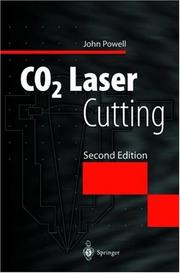
ISBN: 1852330473 1447112792 Year: 1998 Publisher: Berlin : Springer,
Abstract | Keywords | Export | Availability | Bookmark
 Loading...
Loading...Choose an application
- Reference Manager
- EndNote
- RefWorks (Direct export to RefWorks)
The laser has given manufacturing industry a new tool. When the laser beam is focused it can generate one of the world's most intense energy sources, more intense than flames and arcs, though similar to an electron beam. In fact the intensity is such that it can vaporise most known materials. The laser material processing industry has been growing swiftly as the quality, speed and new manufacturing possibilities become better understood. In the fore of these new technologies is the process of laser cutting. Laser cutting leads because it is a direct process substitu tion and the laser can usually do the job with greater flexibility, speed and quality than its competitors. However, to achieve these high speeds with high quality con siderable know how and experience is required. This information is usually carefully guarded by the businesses concerned and has to be gained by hard experience and technical understanding. Yet in this book John Powell explains in lucid and almost non technical language many of these process wrinkles concerning alignment, cornering, pulsing, water jets, material properties, cutting speeds as well as tricks with surface coating and much much more. It is a book which managers and technicians in laser job shops and laser processing facilities would be foolish not to read.
621.9 --- 535.374 --- 621.9.048 --- Working or machining with chip formation. Abrasive working. Cutting, grinding, sheet working. Thread-forming etc. Operations, tools, machines, equipment --- Amplification of radiation by stimulated emission --- Erosion machining, blasting. Spark erosion. Ultrasonic, vibration machining. Machining with particle beams. Electron-beam machining etc. --- Machinery. --- Materials. --- Mechanical engineering. --- Physics. --- Structural control (Engineering). --- Laser beam cutting --- Carbon dioxide lasers --- Mechanical Engineering --- Engineering & Applied Sciences --- Mechanical Engineering - General --- Industrial applications --- 621.9.048 Erosion machining, blasting. Spark erosion. Ultrasonic, vibration machining. Machining with particle beams. Electron-beam machining etc. --- 535.374 Amplification of radiation by stimulated emission --- 621.9 Working or machining with chip formation. Abrasive working. Cutting, grinding, sheet working. Thread-forming etc. Operations, tools, machines, equipment --- Carbon-dioxide-gas lasers --- Gas lasers --- Machining --- Metal-cutting --- Laser drilling --- Erosion machining, blasting. Spark erosion. Ultrasonic, vibration machining. Machining with particle beams. Electron-beam machining etc --- Lasers. --- Photonics. --- Metals. --- Manufactures. --- Optics, Lasers, Photonics, Optical Devices. --- Metallic Materials. --- Manufacturing, Machines, Tools, Processes. --- Mechanical Engineering. --- Engineering, Mechanical --- Engineering --- Machinery --- Steam engineering --- Manufactured goods --- Manufactured products --- Products --- Products, Manufactured --- Commercial products --- Manufacturing industries --- Metallic elements --- Chemical elements --- Ores --- Metallurgy --- New optics --- Optics --- Light amplification by stimulated emission of radiation --- Masers, Optical --- Optical masers --- Light amplifiers --- Light sources --- Optoelectronic devices --- Nonlinear optics --- Optical parametric oscillators --- Usinage --- Decoupage --- Dioxyde de carbone --- Procede de fabrication
| Listing 1 - 6 of 6 |
Sort by
|

 Search
Search Feedback
Feedback About UniCat
About UniCat  Help
Help News
News